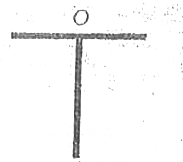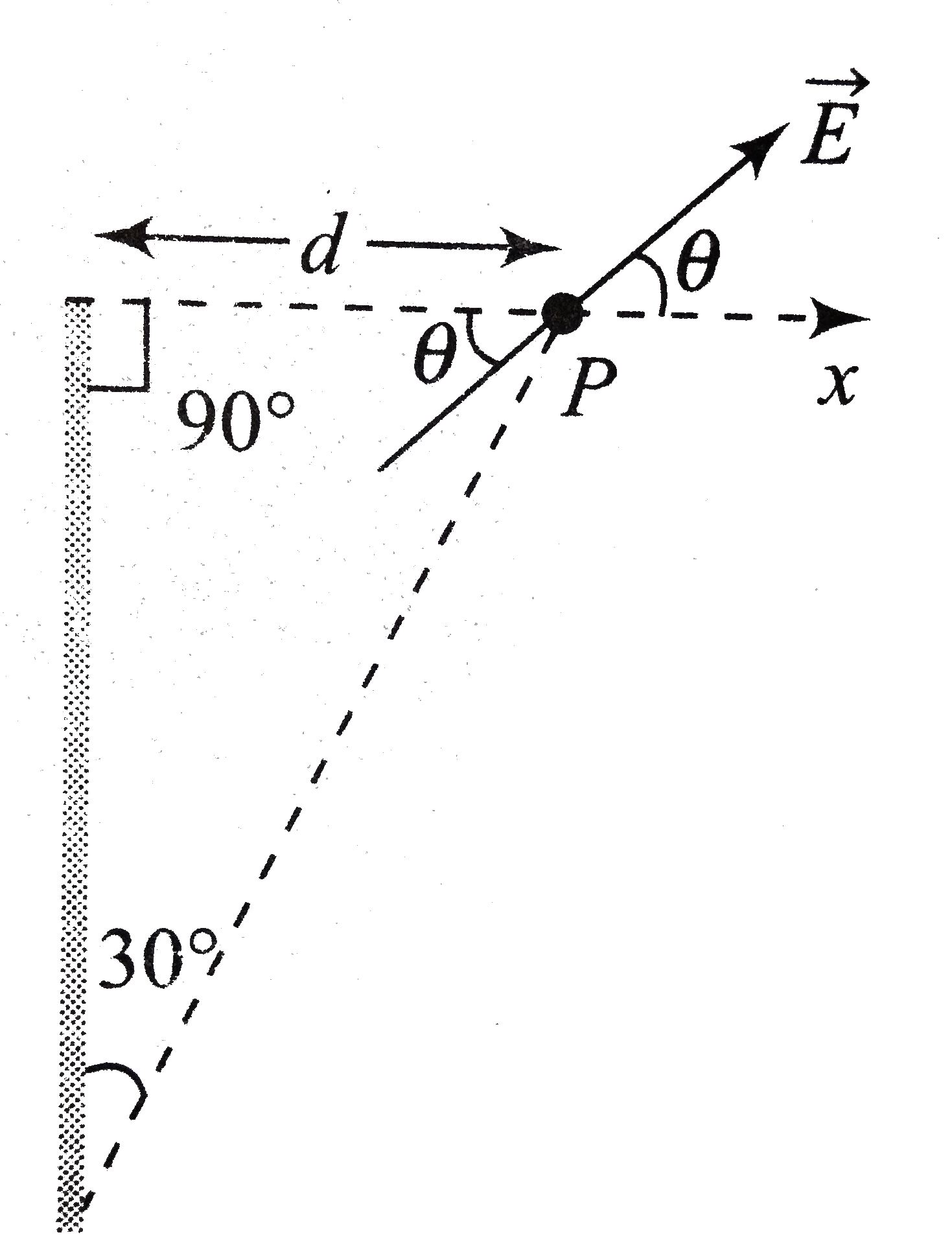Find the electric field at a point P on the perpendicular bisector of a uniformly charged rod. The length of the rod is L, the charge on it is Q and the distance of P from the centre of the rod is a.
The correct Answer is:A, B, D
To find the electric field at point P on the perpendicular bisector of a uniformly charged rod, we can follow these steps:
Step 1: Define the Problem
We have a uniformly charged rod of length L with total charge Q. We want to find the electric field at point P, which is located at a distance a from the center of the rod along the perpendicular bisector.
Step 2: Set Up the Coordinate System
Place the rod along the x-axis, with its center at the origin. Therefore, the endpoints of the rod will be at −L2 and L2. The point P is located at (0,a).
Step 3: Consider a Small Element of Charge
Consider a small element of the rod, dx, located at a distance x from the center. The charge dQ on this element can be expressed as:
dQ=λdx
where λ=QL is the linear charge density.
Step 4: Calculate the Distance from the Charge Element to Point P
The distance r from the charge element dQ to the point P is given by:
r=√x2+a2
Step 5: Calculate the Electric Field Due to the Charge Element
The electric field dE due to the charge element dQ at point P is given by Coulomb's law:
dE=kdQr2=kλdxx2+a2
where k is Coulomb's constant.
Step 6: Resolve the Electric Field into Components
The electric field dE has both vertical and horizontal components. The horizontal components from symmetrical charge elements will cancel out, while the vertical components will add up. The vertical component is:
dEy=dE⋅a√x2+a2=kλdxx2+a2⋅a√x2+a2=kλadx(x2+a2)3/2
Step 7: Integrate to Find the Total Electric Field
Now, integrate dEy from −L2 to L2:
Ey=∫L2−L2kλadx(x2+a2)3/2
Step 8: Solve the Integral
The integral can be solved as follows:
Ey=kλa∫L2−L2dx(x2+a2)3/2
This integral evaluates to:
Ey=kλa(xa2√x2+a2)L2−L2=kλa⎛⎜
⎜
⎜
⎜⎝L2a2√(L2)2+a2−−L2a2√(−L2)2+a2⎞⎟
⎟
⎟
⎟⎠
Simplifying this gives:
Ey=2kλL2a2√L24+a2=kλLa2√L24+a2
Step 9: Substitute for Linear Charge Density
Since λ=QL, we substitute this into the equation:
Ey=kQa2√L24+a2
Final Result
Thus, the electric field at point P is given by:
E=2kQa√L2+4a2
We have a uniformly charged rod of length L with total charge Q. We want to find the electric field at point P, which is located at a distance a from the center of the rod along the perpendicular bisector.
Place the rod along the x-axis, with its center at the origin. Therefore, the endpoints of the rod will be at −L2 and L2. The point P is located at (0,a).
Consider a small element of the rod, dx, located at a distance x from the center. The charge dQ on this element can be expressed as:
dQ=λdx
where λ=QL is the linear charge density.
The distance r from the charge element dQ to the point P is given by:
r=√x2+a2
The electric field dE due to the charge element dQ at point P is given by Coulomb's law:
dE=kdQr2=kλdxx2+a2
where k is Coulomb's constant.
The electric field dE has both vertical and horizontal components. The horizontal components from symmetrical charge elements will cancel out, while the vertical components will add up. The vertical component is:
dEy=dE⋅a√x2+a2=kλdxx2+a2⋅a√x2+a2=kλadx(x2+a2)3/2
Now, integrate dEy from −L2 to L2:
Ey=∫L2−L2kλadx(x2+a2)3/2
The integral can be solved as follows:
Ey=kλa∫L2−L2dx(x2+a2)3/2
This integral evaluates to:
Ey=kλa(xa2√x2+a2)L2−L2=kλa⎛⎜
⎜
⎜
⎜⎝L2a2√(L2)2+a2−−L2a2√(−L2)2+a2⎞⎟
⎟
⎟
⎟⎠
Simplifying this gives:
Ey=2kλL2a2√L24+a2=kλLa2√L24+a2
Since λ=QL, we substitute this into the equation:
Ey=kQa2√L24+a2
Thus, the electric field at point P is given by:
E=2kQa√L2+4a2
Topper's Solved these Questions
- BOOK - DC PANDEY ENGLISHCHAPTER - ELECTROSTATICSEXERCISE - Level 1 Subjective15videos
ELECTROSTATICS
- BOOK - DC PANDEY ENGLISHCHAPTER - ELECTROSTATICSEXERCISE - SUBJECTIVE_TYPE6videos
ELECTROSTATICS
- BOOK - DC PANDEY ENGLISHCHAPTER - ELECTROSTATICSEXERCISE - Level 1 Assertion And Reason19videos
ELECTROSTATICS
- BOOK - DC PANDEY ENGLISHCHAPTER - ELECTROSTATIC POTENTIAL AND CAPACITORSEXERCISE - (C) Chapter exercises50videos
ELECTROSTATIC POTENTIAL AND CAPACITORS
- BOOK - DC PANDEY ENGLISHCHAPTER - GRAVITATIONEXERCISE - All Questions135videos
GRAVITATION
Similar Questions
Find the electric field at a point P on the perpendicular bisector of a uniformly charged rod. The length of the rod is L, the charge on it is Q and the distance of P from the centre of the rod is a.
View SolutionThe electric foield at a point A on the perpendicular bisector of a uniformly charged wire of length l=3m and total charge q = 5 nC is x V/m. The distance of A from the centre of the wire is b = 2m. Find the value of x.
View SolutionWhat is the electric field intensity at any point on the axis of a charged rod of length 'L' and linear charge density λ? The point is separated from the nearer end by a.
View SolutionThe radius of gyration of a uniform rod of mass m and length l about an axis perpendicular to its length and at distance l4 from its centre will be
View SolutionElectric charge Q is uniformly distributed around a thin ring of radius a. find the potential a point P on the axis of the ring at a distance x from the centre of the ring .
 View Solution
View SolutionA uniform rod of mass m and length L lies radialy on a disc rotating with angular speed ω in a horizontal plane about vertical axis passing thorugh centre of disc. The rod does not slip on the disc and the centre of the rod is at a distance 2L from the centre of the disc. them the kinetic energy of the rod is
 View Solution
View SolutionTwo uniform thin rods each of length L and mass m are joined as shown in the figure. Find the distance of centre of mass the system from point O
 View Solution
View SolutionA ring of radius a contains a charge q distributed. uniformly ober its length. Find the electric field at a point. on the axis of the ring at a distance x from the centre.
View SolutionMoment of inertia of a uniform rod of mass m and length l is 712ml2 about a line perpendicular to the rod. Find the distance of this line from the middle point of the rod.
View SolutionThe direction (θ) of →E at point P due to uniformly charged finite rod will be
 View Solution
View Solution

